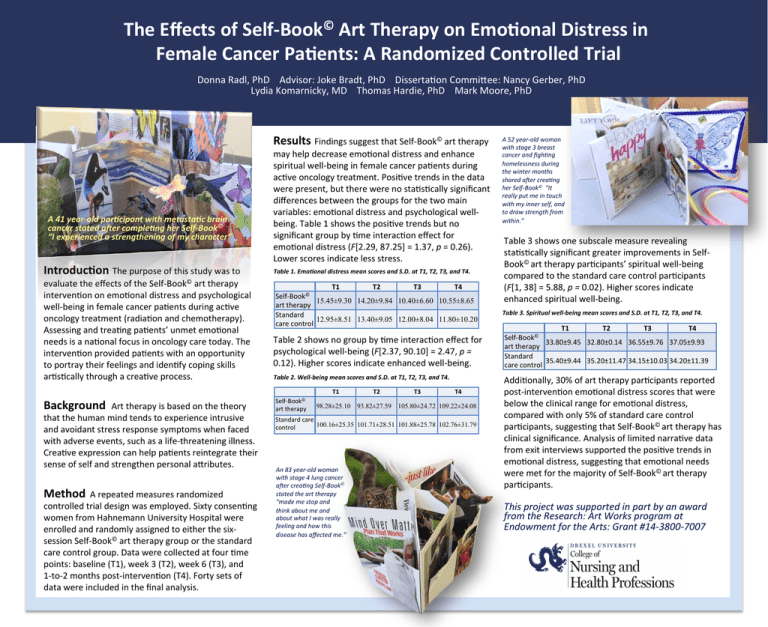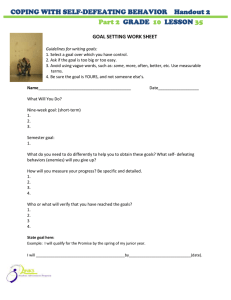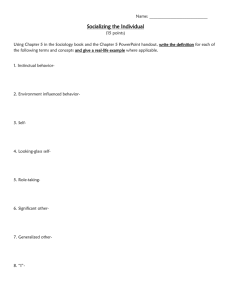Document 11129538
advertisement

The Effects of Self-­‐Book© Art Therapy on Emo9onal Distress in Female Cancer Pa9ents: A Randomized Controlled Trial Donna Radl, PhD Advisor: Joke Bradt, PhD Disserta;on CommiGee: Nancy Gerber, PhD Lydia Komarnicky, MD Thomas Hardie, PhD Mark Moore, PhD 41 year-­‐old par.cipant with metasta.c brain A cancer stated a8er comple.ng her Self-­‐Book© “I experienced a strengthening of my character” Introduc9on The purpose of this study was to evaluate the effects of the Self-­‐Book© art therapy interven;on on emo;onal distress and psychological well-­‐being in female cancer pa;ents during ac;ve oncology treatment (radia;on and chemotherapy). Assessing and trea;ng pa;ents’ unmet emo;onal needs is a na;onal focus in oncology care today. The interven;on provided pa;ents with an opportunity to portray their feelings and iden;fy coping skills ar;s;cally through a crea;ve process. Background Art therapy is based on the theory that the human mind tends to experience intrusive and avoidant stress response symptoms when faced with adverse events, such as a life-­‐threatening illness. Crea;ve expression can help pa;ents reintegrate their sense of self and strengthen personal aGributes. Method A repeated measures randomized controlled trial design was employed. Sixty consen;ng women from Hahnemann University Hospital were enrolled and randomly assigned to either the six-­‐ session Self-­‐Book© art therapy group or the standard care control group. Data were collected at four ;me points: baseline (T1), week 3 (T2), week 6 (T3), and 1-­‐to-­‐2 months post-­‐interven;on (T4). Forty sets of data were included in the final analysis. Results Findings suggest that Self-­‐Book© art therapy may help decrease emo;onal distress and enhance spiritual well-­‐being in female cancer pa;ents during ac;ve oncology treatment. Posi;ve trends in the data were present, but there were no sta;s;cally significant differences between the groups for the two main variables: emo;onal distress and psychological well-­‐ being. Table 1 shows the posi;ve trends but no significant group by ;me interac;on effect for emo;onal distress (F[2.29, 87.25] = 1.37, p = 0.26). Lower scores indicate less stress. Table 1. Emo.onal distress mean scores and S.D. at T1, T2, T3, and T4. T1 T2 T3 T4 Self-­‐Book© art therapy 15.45±9.30 14.20±9.84 10.40±6.60 10.55±8.65 Standard 12.95±8.51 13.40±9.05 12.00±8.04 11.80±10.20 care control Table 2 shows no group by ;me interac;on effect for psychological well-­‐being (F[2.37, 90.10] = 2.47, p = 0.12). Higher scores indicate enhanced well-­‐being. Table 2. Well-­‐being mean scores and S.D. at T1, T2, T3, and T4. T1 T2 T3 T4 Self-­‐Book© art therapy 98.28±25.10 93.82±27.59 105.80±24.72 109.22±24.08 Standard care 100.16±25.35 101.71±28.51 101.88±25.78 102.76±31.79 control An 83 year-­‐old woman with stage 4 lung cancer © aMer creaLng Self-­‐Book stated the art therapy “made me stop and about me and think about what I was really feeling and how this disease has affected me.” A 52 year-­‐old woman with stage 3 breast cancer and fighLng homelessness during the winter months shared aMer creaLng her Self-­‐Book© “It put me in touch really with my inner self, and to draw strength from within.” Table 3 shows one subscale measure revealing sta;s;cally significant greater improvements in Self-­‐ Book© art therapy par;cipants’ spiritual well-­‐being compared to the standard care control par;cipants (F[1, 38] = 5.88, p = 0.02). Higher scores indicate enhanced spiritual well-­‐being. 3. Spiritual well-­‐being mean scores and S.D. at T1, T2, T3, and T4. Table T1 T2 T3 T4 Self-­‐Book© art therapy 33.80±9.45 32.80±0.14 36.55±9.76 37.05±9.93 Standard 35.40±9.44 35.20±11.47 34.15±10.03 34.20±11.39 care control Addi;onally, 30% of art therapy par;cipants reported post-­‐interven;on emo;onal distress scores that were below the clinical range for emo;onal distress, compared with only 5% of standard care control par;cipants, sugges;ng that Self-­‐Book© art therapy has clinical significance. Analysis of limited narra;ve data from exit interviews supported the posi;ve trends in emo;onal distress, sugges;ng that emo;onal needs were met for the majority of Self-­‐Book© art therapy par;cipants. This project was supported in part by an award from the Research: Art Works program at Endowment for the Arts: Grant #14-­‐3800-­‐7007




